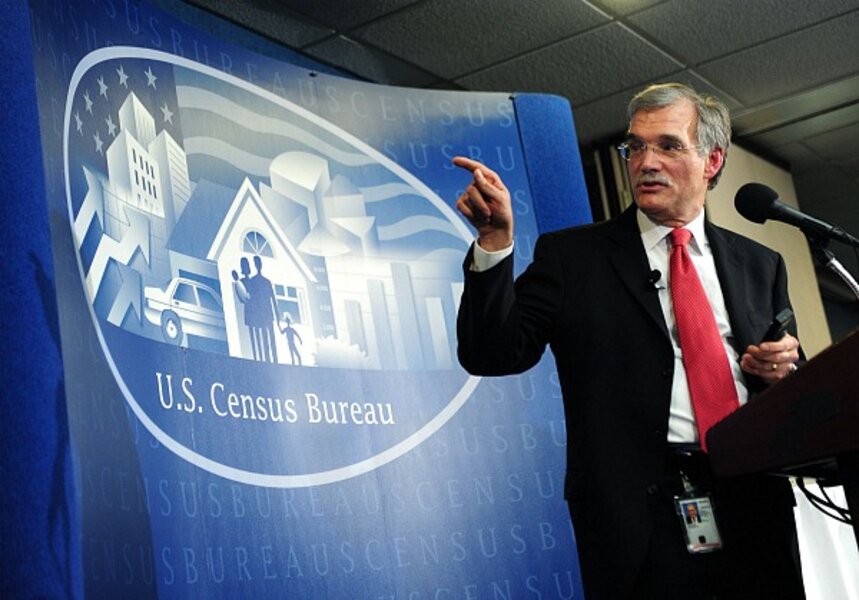Census data show Hispanic boom. How it could impact US politics.
Loading...
White Americans are still the majority in the United States, but they’re rapidly being overtaken by Hispanics, according to the latest Census Bureau report, and this could have important political ramifications.
During the past decade, the Hispanic population in the United States grew 43 times faster than the non-Hispanic white population, the Census Bureau reported Thursday. Put another way, between 2000 and 2010 the US Hispanic population grew 43 percent from 35.3 million to 50.5 million. Its share of the total population rose from 13 to 16 percent. That accounts for more than half the total US population growth since 2000.
At the same time, Census Bureau officials reported, the non-Hispanic white population grew by barely more than 1 percent, dropping as a portion of the total from 69 percent to 64 percent.
RELATED: Could you pass a US citizenship test?
The main reasons? Birth rate and immigration – legal and illegal.
"This is a population that's young, whose growth is driven increasingly by births and not immigration," D'Vera Cohn of the Pew Research Center told the Reuters news agency. “It's a population that's expanding into virtually every county of the country, and growing especially sharply in states where Latinos had not been a presence a decade or so ago.”
Charting the population trends
While the number of Hispanics continued to grow in the Southwest, Florida, and several other parts of the country where their numbers have been traditionally high, they’re growing rapidly elsewhere as well – particularly in the South, including North Carolina and Alabama.
“The states with the largest percent growth in their Hispanic populations include nine where the Latino population more than doubled, including a swath in the southeast United States – Alabama, Arkansas, Kentucky, Mississippi, North Carolina, Tennessee, and South Carolina. The Hispanic population also more than doubled in Maryland and South Dakota,” reports the Pew Hispanic Center in an analysis of the Census Bureau report Thursday.
“In six states, growth in the Hispanic population accounted for all of those states’ population growth; if the Hispanic population had not grown, those states would not have grown,” adds Pew. “They included Illinois, Louisiana, Massachusetts, New Jersey, New York and Rhode Island. In Michigan, the state population declined over the decade but the Hispanic population grew.”
The figures for younger Americans portend an accelerating trend. Hispanics now make up 23 percent of the population younger than 18.
The number of states where more than half the children are minorities (many if not most of them Hispanics) has grown to 10: Mississippi, Georgia, Maryland, Florida, Arizona, Nevada, Texas, California, New Mexico, and Hawaii.
A potential political impact
The steady and continuing rise in the Hispanic population could have political impact, perhaps as soon as next year’s presidential election.
Some US Senate races may be at stake as well – particularly those with growing Hispanic populations where the GOP hopes to unseat incumbent Democrats: Jon Tester in Montana, Ben Nelson in Nebraska, and Claire McCaskill in Missouri.
In last November’s congressional races, 60 percent of Latino voters supported Democratic candidates in House races while 38 percent supported Republican candidates, according to the Pew Hispanic Center. In 2008, Latinos voted for Barack Obama by more than 2 to 1 (67 to 31 percent) over John McCain.
"If this becomes an election all about the economy, there's a major opening for a Republican candidate to appeal to Latino voters," Republican pollster Bob Moore told The Hill, a political newspaper and website. "But if it becomes about immigration, then it could be problematic for the Republican nominee."
Even with the economy a major concern, immigration remains an important issue for Hispanics, however.
Seventy-seven percent say most illegal immigrants should be given “a path to citizenship” compared to just 11 percent who believe such immigrants should be “forced to leave the country,” according to a poll conducted last year for the immigrants’ rights group America’s Voice.
Immigration and the Hispanic vote could be key for some threatened Democrats trying to hold onto their seats – as it was for Senate majority leader Harry Reid of Nevada in his hard-fought race last year against tea party favorite Sharron Angle.
One big unknown in the rise in the Hispanic population is the number who are in the United States illegally, which the Census Bureau does not track. How many Hispanics in fact will be able to vote?
By 2050, the Census Bureau has projected, ethnic and racial minorities in the United States will become the majority, and nearly one-third of all US residents will be Latino – nearly twice the percentage today.
In 2010, Texas joined California, Washington, D.C., Hawaii, and New Mexico as places where non-Hispanic whites already make up less than half the population.





